 Image search results - "Olympic" Image search results - "Olympic" |

JR Nagano Station festooned with Olympic logos.
|
|
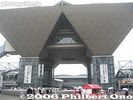
On June 6, 2004, the Athens Olympic Torch Relay came through Tokyo as it has been doing at all cities in the world which had held a Summer Olympics. Starting point: Tokyo Big SightI chased the flame for Athens at several points in Tokyo.
|
|
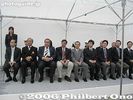
Dignitaries at the torch relay starting ceremony.
|
|

Welcome sign at Nagano Station
|
|
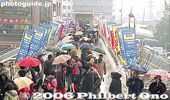
Nagano Station, East Exit to Olympic PlazaAt the East Exit of Nagano Station, this bridge, lined with advertising banners, led the way to the Olympic Plaza which featured ten tent pavilions made by official sponsors.
|
|
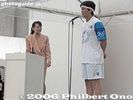
Nagashima Kazushige substitues for his father, baseball hero Nagashima Shigeo, who was hospitalized.
|
|
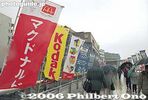
To Olympic Plaza
|
|

An Olympic torch attendant stands by to hand over the torch. In his right hand, he holds a small lantern housing a little flame in case the main torch is snuffed out.
|
|

Pavilion by Kirin Brewery.Notice the "wrap" bus passing in front.
|
|
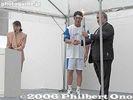
The Greek ambassador to Japan gives the torch to Kazushige.
|
|

Olympic PlazaSnowlets House and Kodak's pavilion behind it.
|
|
|
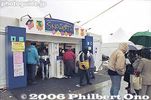
Entrance to Snowlets House at Olympic Plaza.The official store for Olympic souvenirs. There were a lot of ticket scalpers (all foreigners) hanging around the entrance. Inside, there was a ticket counter for events which still had seats.
|
|
|
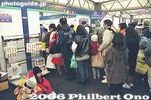
Snowlets HouseIt was packed. This is part of the checkout line. There were four checkout lines and each one was about 30 meters long. The line went pretty fast though. They had all kinds of souvenirs: T-shirts, sweatshirts, flags, postcards, pins, key chains, necklaces, stuffed Snowlets, mugs, and even jewelry. I went on the 6th day of the Games and it still had everything well in stock. But I later heard that the shelves were laid bare well before the Games ended.
|
|
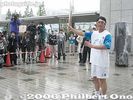
About 11 am: Here we go folks, the first of 136 runners in Tokyo.
|
|
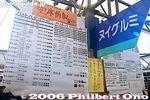
Snowlets House, ticket availability
|
|
|
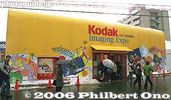
Kodak's Kodak-yellow pavilionOn the day I went in, they introduced Jamaica's bobsled team. They are very popular in Japan, largely due to the comedy movie "Cool Running" which was aired in Japan before the Nagano Games started.
|
|

Kazushige runs on the sidewalk in Odaiba.
|
|
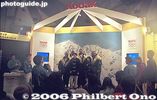
Jamaica's bobsled team in Kodak PavilionThey introduced Jamaica's bobsled team. They are very popular in Japan, largely due to the comedy movie "Cool Running" which was aired in Japan before the Nagano Games started.
|
|

Ginza 4-chome, Mitsukoshi Dept. StoreDespite the rain, all these people showed up just to see the torch relay. No one knew who would pass through here. But since Ginza was a major area of Tokyo, we assumed that it would be someone quite famous.
|
|
|

Looking toward Matsuya Dept. Store.
|
|

Kita Nagano StationTo get to Aqua Wing, the ice hockey rink, we had to take a local train from Nagano Station for a short ride to the next stop at Kita Nagano Station. This Kita Nagano Station was a tiny little train station certainly not meant for large crowds. It was unbelievably small. It took some minutes before we could get out of the station which was not much larger than a normal living room. The door was also small, enough for only two people to get out at one time.
|
|

Cheerleaders even...
|
|
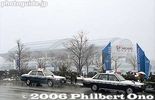
Aqua Wing ice hockey rink
|
|

Here they come
|
|
|
|

Police escort
|
|
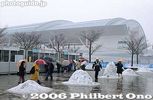
Aqua Wing
|
|

Motorcycle escort
|
|
|
|

It's singer Hashi Yukio (wow).
|
|
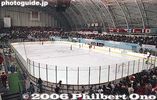
Aqua Wing ice hockey rinkMost of the women's ice hockey matches were held at a stadium called Aqua Wing which is actually an indoor swimming pool with a sliding roof. It seemed like we were in a huge oil drum cut in half.
|
|

Torch runner and famous singer Hashi Yukio passes through Ginza
|
|
|
|

Koga Toshihiko (gold medalist in judo) carries the torch to Asakusa, in front of Kaminarimon Gate.
|
|
|
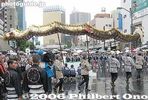
Asakusa-style welcome for the sacred Olympic flame. (Golden Dragon Dance)
|
|
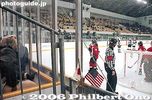
My Japanese and American flagsI tacked the flags onto the glass and proudly displayed them in front of my seat behind the goal. That's what you do when you love both countries. Since I was sitting at rinkside behind the goal, the flags (and my face and camera) could be seen on the TV broadcast.
On the left of the photo, you can see the goal referee who was sitting in a glass box. She wrapped herself in a blanket. As you can expect, the place was not warm like a coffee shop.
|
|

Fireman's acrobatics
|
|

Cheering section for Yuiko SatomiCollege cheering section for Yuiko Satomi, a defense player for Japan.
|
|

Fireman's acrobatics
|
|
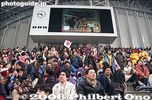
The crowd behind me.
|
|

Koga takes the torch again to light the next torch.
|
|

Start of game
|
|
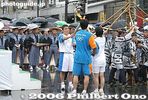
Passing on the flame at Asakusa
|
|

The Nippon team huddles.The Nippon team huddle and psych themselves up before the start of the game.
|
|
|
|

Cheerleaders blocking our view of the torch runner
|
|
|
|
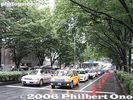
Omotesando with path coned off for the torch runner
|
|
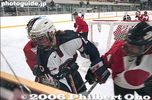
Banging the glassI liked it when the puck slammed into the glass (BOOM!) in front of me. The protective glass, by the way, must have been at least an inch thick.
|
|
|
|
|
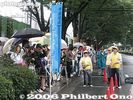
Torch relay point
|
|
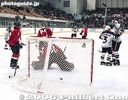
A US player scores and celebrates to the dismay of Japan.
|
|
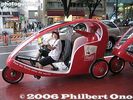
Bicycle cab
|
|
|
|

Olympic ring sculpture along Omotesando
|
|

A US player scores and celebrates to the dismay of Japan.
|
|
|
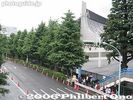
Yoyogi GymnasiumTorch relay path is coned off.
|
|
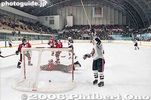
A US player scores and celebrates to the dismay of Japan.
|
|

Coming down Omotesando, first are sponsor vehicles
|
|

5-0 on scoreboard during 1st period.In the 1st period, the scoreboard shows 5-0 in favor of the US.
|
|
|
|
|

Photographers' truck
|
|
|

Torch runner at Omotesando, for Athens 2004 Olympic Torch RelayMiura Yukari, a high school student from Fukushima Pref.
福島工業高等専門学校に通い、部活動はソフトボールという三浦由香里さん。
|
|

Resurfacing the ice during intermission
|
|

Miura Yukari, a high school student from Fukushima Pref.Miura Yukari, a high school student from Fukushima Pref.
福島工業高等専門学校に通い、部活動はソフトボールという三浦由香里さん。
|
|
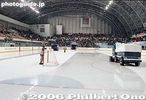
Resurfacing the ice during intermission
|
|

Jacket
|
|
|
|

Stage at Tokyo City Hall
|
|
|
|

The crowd waits to see who the final torch runner is.
|
|
|

It's Fukuhara Ai, table tennis player.
|
|

Nagano Winter Olympics women's ice hockey match.
|
|

Ai-chan and Tokyo governor Ishihara Shintaro hold the torch together.
|
|
|
|
|
|
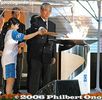
Ai-chan and Tokyo governor Ishihara Shintaro light the cauldron.
|
|
|

The governor speaks.
|
|
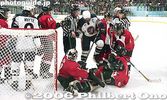
Frenzy in front of Japan's goal.
|
|
|
|
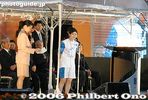
Ai-chan speaks.The frustrating thing about the torch relay was that they did not say which runner would be running where. A list of runners was made public, but there was no information about where they would run.
|
|
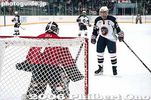
Face to face. Japan's goal keeper was busy, busy, busy.
|
|

Japan's goalie takes a break at Nagano Winter Olympics women's ice hockey match.Her helmet is dotted with Print Club photo stickers.
|
|

Nagano Winter Olympics women's ice hockey match.
|
|
|
|
|
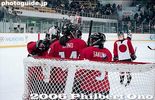
Japan team mates try to comfort the goal keeper right after the US scores.
|
|
|
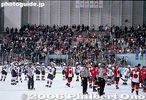
Game ends with USA scoring 10 goals and Japan zero.The final score was 10-0. Japan went on to lose all five of their matches and the US team went undefeated for the gold medal. The US and Canadian men's hockey teams were not the only ones who were put to shame at Nagano.
Japan's women's ice hockey team must feel pretty rotten about their pitiful playing on their home turf.
|
|
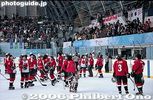
Total winners beat the total losers...The U.S. team went on undefeated to win the first Olympic gold medal in women's ice hockey. Japan lost all five of its matches (they scored a total of 2 goals) putting them in last place among the six women's hockey teams.
|
|
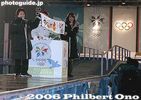
Olympics auction hosted by Emi Watanabe (left), a former Olympic figure skater.
|
|

Kids gathered at Nagano Station.
|
|
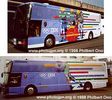
IBM billboard busesThe decals covering the window portion of the decals have little holes in them and from the inside of the bus, the decals are transparent. IBM's Olympic pins and jacket were also based on these bus decal designs.
|
|

More billboard busesCoca-cola adorned some of the local city buses in Nagano.
|
|
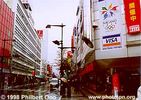
The road from Nagano Station to Zenkoji Temple.Lots of Olympics advertising.
|
|

Local busThis was not a "wrap" bus, but it still had a Kirin ad (made of cloth) on the front.
|
|

Souvenir shop"Japanese dress Kimono and so on." Awkward or mistaken English is nothing new in Japan. They should've used a Japanese-flag motif instead.
|
|

Pin sellerThis American woman was selling pins in Nagano at her seventh Olympics. Olympic pins proved to be very popular among the Japanese.
Apparently there are pin sellers who travel to all the Olympics and major sports events making a living as a pin vendor.
|
|
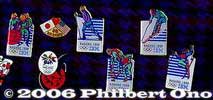
IBM pins (my collection)The IBM pins were being sold for 1,000 yen each. Some people were selling them for up to 2,000 yen.
|
|
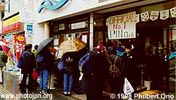
"Official No. 1 Pin Club" ShopShop selling Olympic pins. Prices ranged from 500 yen to 4,000 yen.
|
|

Fruit gelato standFruit gelato storefront with national flags and "Welcome to Nagano" signs.
|
|

PolicemanPoliceman in special uniform designed just for the Nagano Games. The uniform supposed to make them look more friendly.
|
|
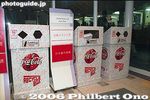
Recycle bins by Coca-cola
|
|

Tokyo Station Olympics souvenir shopThis little space (operated by official sponsor Mizuno) in the Yaesu underground mall at Tokyo Station used to have shelves full of Olympic souvenirs. On the day before the Olympics, I saw that they were selling towels, T-shirts, sweatshirts, jackets, mugs, postcards, Snowlets, key chains, and other things. I visited this place again on the last day of the Olympics (when I took this photo) and found a sign saying that they had sold out of Olympics souvenirs. According to the clerk, most were sold out about a week before.They only had a single rack selling expensive framed Olympic prints. The story was the same for the Snowlets House in Nagano and the Tokyo Branch at Mitsukoshi Dept. Store in Nihonbashi. I'm glad I bought my souvenirs early on.
|
|

English programme (1,800 yen)
|
|

Palm-size stuffed Snowlet (official mascot)
|
|

Key chain (1,000 yen)
|
|

Postcard set (400 yen)
|
|
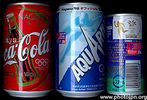
Olympics logo on official drinksBesides Coke, Coca-Cola also makes Aquarius (sports drink) and Georgia canned coffee. The Olympics logo and "Nagano 1998" figure prominently on the limited-edition cans. On the Aquarius can, notice the image of a speed skater. On the back of the Georgia coffee can, see the image of the torch relay runner. Georgia coffee was prominently advertised during the nationwide Olympic torch relay to Nagano.
|
|
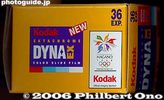
Olympics logo on official film (not FujiFilm)Kodak was the official Olympics film in a country where 70 percent of the film market belongs to Fuji Film. It must have been sweet revenge for Kodak because Fuji Film was the official film at the Los Angeles Olympics in 1984. Kodak has been the official film sponsor for all Olympic Games since then. It will also be the official film for the Sydney Games in the year 2000.
|
|

Even official Olympics miso pasteWould you believe the official miso? Hanamaruki Foods of Nagano was an official supplier for the Nagano Winter Games. Miso soup must have been a staple item for breakfast (and dinner) at the Olympic Village. I found this at my local supermarket.
|
|

Amway at Tokyo StationAmway shows the way to the Nagano Shinkansen platform for people getting off the Narita Express train which comes from Narita Airport.
|
|
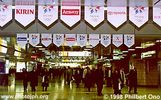
Tokyo Station
|
|

Tokyo Station: Official postersThese were painted by Koji Kinutani and plastered everywhere in Tokyo Station. These were being sold to the public for about Y5,000.
|
|

Yaesu underground mall: Speed skater outfits made by MizunoMizuno, an official sponsor, set up a nice Olympics exhibition in the Yaesu underground mall at Tokyo Station. There was a nice photo exhibit of past and current Winter Games and a souvenir shop as well. These three photos show part of Mizuno's exhibition.
A few speed skater outfits made by Mizuno. You may recognize the suits for China, Japan, and the USA.
|
|

A four-man bobsled.
|
|

An elderly couple are among a crowd of people who watched the men's hockey finals on the TV set.
|
|

Nagano ShinkansenThe Nagano shinkansen has a duckbill snout.
|
|
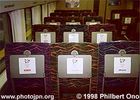
Seat backs and ad stickersThe train's seat backs had advertising stickers. When the Nagano Shinkansen reaches a terminal station (Tokyo and Nagano), the seats can turn around by itself? One thing less to do by the train's cleaning ladies.
|
|
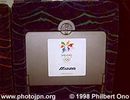
Ad sticker on tray table
|
|
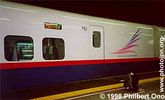
During the Olympics, the morning trains from Tokyo were always crowded. However, the last trains from Nagano to Tokyo were almost empty.
|
|

Victory parade for Japan's Rio Olympic and Paralympic medalists was held on Oct. 7, 2016 in Tokyo's Ginza and Nihonbashi areas. At Nihonbashi near Mitsukoshi Dept. Store.These photos were taken at Nihonbashi.
|
|

About 800,000 crowded the sidewalks along the 2.5 km route on Chuo-dori that goes through Ginza 4-chome.
|
|
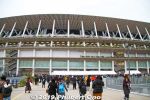
Approaching the Olympic Stadium. The white tent is where we had to show our tickets.
|
|

Crowd control
|
|

Stadium gates opened at 2 pm, stadium seating opened at 4:30 pm, and the program started at 6:30 pm. Cold, overcast day, but fortunately, it didn't rain.
|
|

Crazy about the Olympics, that's Japan.
|
|
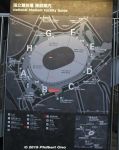
The stadium grounds has four gates (Sendagaya Gate, Gaien Gate, etc.) from the direction of train/subway stations. This map shows how far each train/subway station is.The closest is JR Sendagaya Station (440 meters) and Kokuritsu Kyogijo subway station (130 meters).
The stadium itself has eight main entrances from A to H. These main entrances further branch off into smaller entrances such as A1, A2, etc., leading to different floors and seating blocks.
The stadium seating sections are labeled Main Stand, Back Stand, North Stand, and South Stand. Each stand comprise three inclined tiers of seating. The Main Stand is the prime section. Gate F is nearest to the Japan Olympic Museum where the Olympic rings are.
|
|

Passing out a newspaper extra about the parade.
|
|
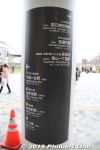
This shows how far each train/subway station is.
|
|

The parade was headed by policewomen on white motorcycles. They wore the red Olympic uniform.
|
|
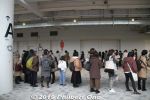
Long line for the women's restroom on the ground floor. There are men's and women's restrooms on each floor. If the line is too long, just look for another one.
|
|

Policewomen on white motorcycles.
|
|
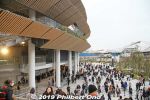
It was the first time the stadium saw this many people.
|
|
|
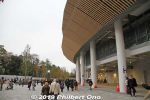
I walked completely around the stadium on the ground level outside.
|
|
|
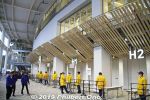
Each gate had a bag checkpoint.
|
|

Start of the parade of 50 Olympian and 37 Paralympian medalists on four double-decker, open top buses and two flatbed trucks. The Olympians wore red uniforms while the Paralympians wore white.
|
|
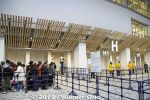
Line to enter Gate H.
|
|

Paralympians on a flatbed truck first appeared. They are wheelchair rugby players who won the bronze.
|
|
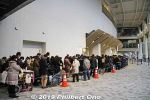
Line to enter Gate H.
|
|

Paralympians on a flatbed truck first appeared. They are wheelchair rugby players who won the bronze.
|
|
|

Paralympian wheelchair rugby players Ikezaki Daisuke, Ike Yukinobu 池崎大輔 池透暢
|
|
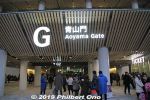
Gate G, Aoyama Gate
|
|
|
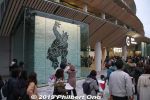
Near Gate G, a large, fresco mosaic wall mural of Nomi no Sukune, a legendary sumo wrestler posing as a victor. By pioneering artist Hasegawa Roka (長谷川路可 1897–1967). This was preserved and moved here from the old National Stadium. So this work dates from 1964. 「野見宿禰」
|
|
|

Mosaic wall mural of Nomi no Sukune, a legendary sumo wrestler posing as a victor. By pioneering artist Hasegawa Roka (長谷川路可 1897–1967).
|
|

Nakazato Shin, wheelchair rugby bronze medalist. 仲里進
|
|
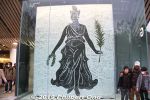
Another fresco mosaic wall mural by Hasegawa Roka. The Greek Goddess of Victory, depicting "Honor." This was preserved and moved here from the old National Stadium. 「勝利の女神」
|
|
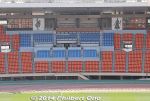
This is where Hasegawa Roka's pair of fresco wall murals were in the old National Stadium's main stand. Saw it in May 2014 when I toured the old 1964 Olympic Stadium before it was torn down to make way for the new stadium.
|
|

Paralympians on a flatbed truck first appeared. They are wheelchair rugby players who won the bronze.
|
|
|

Looks like fire escape stairs, but they are normally used to exit the stadium. It was closed while people were entering the stadium (using escalators). The stairs were opened after the event ended.
|
|

Wheelchair tennis medalists.
|
|

Boccia medalists 廣瀬隆喜 杉村英孝
|
|
|
|
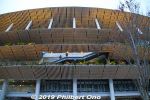
The stadium's design theme was "Forest Stadium." (杜のスタジアム). Lots of cedar lumber on the exterior. The wood came from all 47 prefectures and they point toward the place where they came from.
|
|
|
|
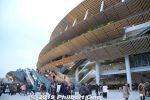
Stairs and escalator to the stadium's 2nd tier seats.
|
|

Yui Kamiji, bronze medalist in women's single wheelchair tennis. 上地結衣
|
|
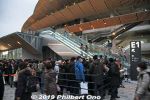
Stairs and escalator to the stadium's 2nd tier seats.
|
|
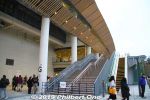
Stairs and escalator to the stadium's 2nd tier seats.
|
|

Saida Satoshi, wheelchair tennis bronze medalist in Rio. 齋田悟司
|
|
|

Olympian buses coming over Nihonbashi Bridge. As I had hoped, Nihonbashi was not as crowded as Ginza. In Ginza, there were people who waited from midnight or 5 am this morning to see this parade.
|
|
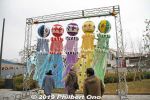
Tanabata streamers from Sendai, Miyagi Prefecture. One event highlight was Tohoku festivals.
|
|

Rio Olympic medalists parade on Oct. 7, 2016 in Ginza-Nihonbashi, Tokyo.
|
|
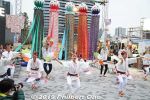
Outside Gate E, there was a short pre-event performance of the Sendai Suzume Odori dance from Sendai, Miyagi Prefecture. The Suzume Odori (Sparrow Dance) is held in late July near Sendai Station. They performed in front of Tanabata streamers for which Sendai is famous in early Aug. 仙台すずめ踊り http://www.suzume-odori.com/
|
|
|
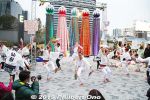
Sendai Suzume Odori dance. They were also going to be part of the main program inside the stadium. 仙台すずめ踊り http://www.suzume-odori.com/
|
|
|
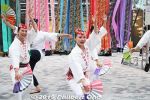
Sendai Suzume Odori dance.
|
|
|

Sendai Suzume Odori dance.
|
|
|
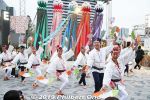
Sendai Suzume Odori dance.
|
|
|
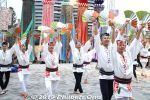
Sendai Suzume Odori dance.
|
|
|
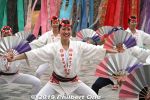
Sendai Suzume Odori dance.
|
|
|
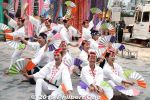
Sendai Suzume Odori dance.
|
|

Kaori Icho, freestyle wrestler who made Olympic history by winning the Olympic gold medal four times in a row (since Athens in 2004). No other woman has won an Olympic gold that many consecutive times for an individual event.
|
|
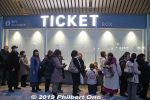
Stadium's ticket box office. It was closed since tickets to this event was sold in advance. First you had to apply for the ticket lottery online. If you won a ticket in the lottery (held at least 3 times), you could pay for it by credit card or at a convenience store. The ticket lottery and website were in Japanese only and geared for Japan residents with a cell phone. Very puzzling since it effectively shut out overseas visitors from buying a ticket. I didn't see any foreigners in the crowd. And yet, the event MC kept mentioning how it was for all nationalities, abled-bodied and disabled, all genders, all ages, etc., etc. No event info in English at all.
|
|

Kaori Icho, freestyle wrestler who made Olympic history by winning the Olympic gold medal four times in a row (since Athens in 2004).
|
|
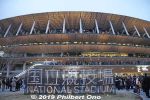
Popular photo spot with the "National Stadium" sign. Near Gaien Gate.
|
|
|
|
|
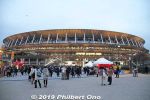
The stadium as seen from Gaien Gate. This area is where they had food stalls and corporate sponsor booths.
|
|
|
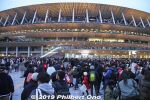
The stadium as seen from Gaien Gate.
|
|
|
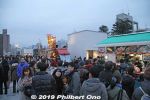
Food stalls.
|
|

Sprinters and silver medalists Yoshihide Kiryu (middle) and Shota Iizuka (right) who got their Olympic glory in the 400-meter relay race
|
|
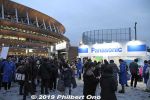
Corporate sponsor booths.
|
|

Sprinters and silver medalists Yoshihide Kiryu (middle) and Shota Iizuka (right) who got their Olympic glory in the 400-meter relay race
|
|

Gate B2.
|
|
|
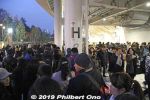
We all had reserved seating so there was no rush to get to our seats. But there was this long line for Gate A that led to seats on all three tiers (1st to 4th floors) in this section on the Main Stand. The line wound back and forth four times before we headed for Gate A.
|
|
|
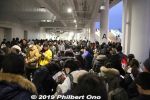
Long and winding line for Gate A.
|
|

On the right is Ayaka Takahashi, Japan's first badminton player to win an Olympic gold medal.
|
|
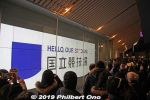
The line moved quickly though. It took about 15 min. to get to the gate to go inside.
|
|

On the left is synchronized swimmer Yukiko Inui who won two bronze medals for duet synchronized swimming and Team synchronized swimming at Rio.
|
|

Entering Gate A for security check of our bags. Notice that Gate A branches off into smaller gates from A1 to A6. A1 goes to the 1st floor, A6 goes to the 4th floor.
|
|
|

Items not allowed: Knives, scissors (longer than 5.5 cm), poison, illicit drugs, flammable things, flares, fireworks, firecrackers, explosive items, oil, hammers, screwdrivers, chains, ice picks, glass bottles, cans, canned goods, raw eggs, and more. Plastic (PET) bottle drinks are allowed, but it may be subject to inspection.
Even this sign was not in English. So I guess they weren't expecting foreigners to attend this event.
|
|

Paralympians not on wheechairs.
|
|

Gate A6 led to escalators going to the 4th floor. The admission ticket tells you which gate to go to.
|
|

Paralympians
|
|
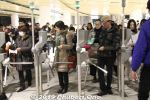
The turnstile used a QR code scanner. Show the QR code on your ticket and the turnstile unlocks for you to pass through.
|
|
|
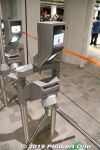
The turnstile scanner machine (spare ones here).
|
|

Paralympians Tanaka Mai (Women's tandem B cycling time trial silver medalist, pilot for Kanuma Yurie), Kanuma Yurie (Women's tandem B cycling time trial silver medalist), Masaki Fujita (Road Cycling TT bronze medalist) 田中まい 鹿沼由理�
|
|
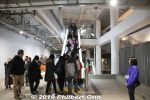
Escalator to the upper floors.
|
|

Misato Michishita, silver medalist in women's Paralympic marathon in Rio 2016. 道下美里
|
|
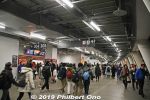
Concourse on the 4th floor. This is open-air. Quite cold this day.Concourse on the 4th floor. This is open-air. Quite cold this day. I felt sorry for the staff who were working here, standing outside the corridor entrance to the seats.
|
|

Misato Michishita, silver medalist in women's Paralympic marathon in Rio 2016. 道下美里
|
|
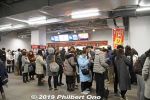
A number of concession stands along the concourse, but long lines. I brought my own food and drinks, so I didn't bother to stand in line. No vending machines in the stadium. The cheapest drinks were ¥300.
|
|
|
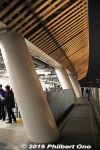
Outside the concourse.
|
|
|
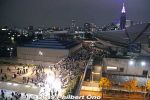
View outside the concourse, looking toward Tokyo Metropolitan Gymnasium and Sendagaya Station.
|
|
|
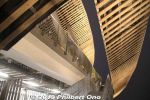
Stairs to the 5th floor where there is an open-air concourse with potted plants (Sora no Mori). But it was closed.
|
|
|
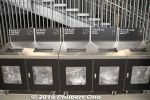
On the concourse, trash bins for burnables, plastics, and PET bottles.
|
|
|
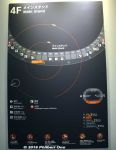
Layout of seating blocks on the Main Stand on the 4th floor (Tier 3). Notice the many concession stands and restrooms. It may be confusing to see three seating tiers, but they are on different floors. The 1st tier is on the 1st floor, the 2nd tier is on the 2nd and 3rd floors, and the 3rd tier is on the 4th and 5th floors.
|
|
|
|
|
|
|